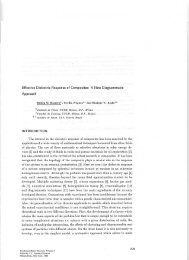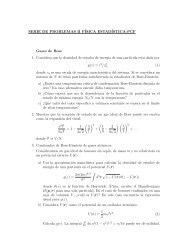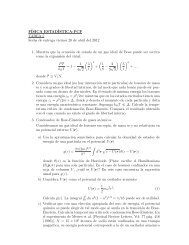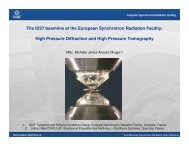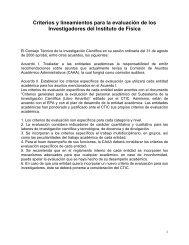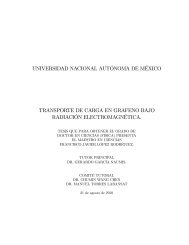Feature Article J. Phys. Chem. C, Vol. 111, No. 10, 2007 3813Figure 3. Simulated optical absorbance for linear-polarized light from 0° to 90°. The polarizati<strong>on</strong> indicated in the sec<strong>on</strong>d plot is the same for all.The wavevector of the incident electromagnetic field respect to the major axis is depicted.Figure 4. Extincti<strong>on</strong> efficiency of a silver cube nanoparticle as afuncti<strong>on</strong> of the wavelength of the incident light, and immersed invacuum and in silica. The main six surface plasm<strong>on</strong> res<strong>on</strong>ances areindicated.a rich structure of peaks, which is better observed when n )1.47. We menti<strong>on</strong>ed in secti<strong>on</strong> III that, for media with n > 1,the spectrum is red-shifted with respect to vacuum. Furthermore,this shift is not just by a c<strong>on</strong>stant, because it depends <strong>on</strong> theproper mode itself. It is clear from Figure 4 that the SPRs arespread out as n > 1, and the red shift is larger for SPRs atgreater wavelengths. For instance, when n ) 1.47, we canidentify six SPRs more easily than when n ) 1. These sixres<strong>on</strong>ances were found by Fuchs, 37 who calculated nine SPRswhere <strong>on</strong>ly six of them account for more than the 96% of thespectrum. The SPRs 1 and 2 corresp<strong>on</strong>d to the dipolar andquadrupolar charge distributi<strong>on</strong>s and are located at 506 and 466nm, respectively, and their amplitude is particularly high at thecorners. The modes 3-6 are at smaller wavelengths and showhigher multipolar charge distributi<strong>on</strong>s. The amplitude of modes5 and 6 is high at the center of the faces, whose normal pointsal<strong>on</strong>g the electric field. 37Now, let us compare Q ext of a nanocube to those for differentTCs, the IH and the sphere. The TCs are obtained by truncatingthe eight corners of the cube by l × r, where l is the length ofthe cube’s side and 0 < r E 1/2. We label the differenttruncati<strong>on</strong>s with the number r. When r ) 1/2 a cuboctahedr<strong>on</strong>(CO) is obtained. Six octag<strong>on</strong>s and eight triangles compose allof the TCs, except the CO that is composed by six planar squaresand eight triangles. All of the TCs have 14 faces. Finally, if weperformed a symmetric truncati<strong>on</strong> of the cube with a largernumber of planes, <strong>on</strong>e could arrive to the IH, and with an infinitenumber of planes to the sphere. In Figure 5, the extincti<strong>on</strong>efficiencies of TCs with r from 1/8 to 1/2 are shown. The opticalresp<strong>on</strong>se below 325 nm is the same independently of themorphology, as expected. It is observed that, even for theFigure 5. Extincti<strong>on</strong> efficiencies as a functi<strong>on</strong> of the wavelength ofthe incident light of a silver cube, different truncated cubes, and aspherical nanoparticle.smallest truncati<strong>on</strong> (r ) 1/8), the SPRs are very sensitive tothe morphology. In this case, the dipolar SPR is blue-shiftedabout 30 nm. The locati<strong>on</strong> of the dipolar and quadrupolar SPRsare now very close, such that, <strong>on</strong>ly <strong>on</strong>e wide peak is observedaround 474 nm, which is more intense. The SPR 3 has vanished,and the others show a slightly blue shift. The same trend isobserved for larger truncati<strong>on</strong>s, and when the CO is obtainedwith r ) 1/2, the spectrum becomes wider. For the IH, thespectrum does not show the individual peaks, is narrower thanthe <strong>on</strong>e for the CO, but is wider than the sphere that shows asingle peak, which corresp<strong>on</strong>ds to the dipolar SPR.In summary, it was found that as the truncati<strong>on</strong> r increases(i) the main res<strong>on</strong>ance is always blue-shifted, (ii) the SPRs atsmaller wavelength are closer to the dominant mode, so theycan be hidden, and (iii) the width of the main SPRs increases.For instance, the full width at the half-maximum (fwhm) of theTC with 1/8 is about 70 nm, whereas the <strong>on</strong>e with r ) 1/2(CO) is about 115 nm. This means that the sec<strong>on</strong>dary res<strong>on</strong>ancesdo not disappear but are closer to the dominant SPR, producingwider spectra at larger truncati<strong>on</strong>s. For the IH and the sphere,the fwhm are about 60 and 20 nm, respectively. This indicatesthat the SPRs vanish as the number of faces increases or whenthe symmetry of the NP is greater. The res<strong>on</strong>ance of the sphereis always at the smallest wavelength, whereas the main SPR ofthe IH is blue-shifted with respect of the cubes but at a largerwavelength of the sphere. Then, as the number of faces of theNP increases (i) there are fewer SPRs, (ii) the main res<strong>on</strong>anceis blue-shifted, and (iii) the fwhm of the spectra decreases.B. Decahedral Morphology. Another important morphologypresent in metal NPs is the DH or pentag<strong>on</strong>al bipyramid, whichis obtained by different synthesis methods. 21-26 The regular DH,
3814 J. Phys. Chem. C, Vol. 111, No. 10, 2007 NoguezFigure 6. Extincti<strong>on</strong> efficiency as a functi<strong>on</strong> of the wavelength of theincident light for the regular decahedr<strong>on</strong> and its truncated morphologiesfor parallel light polarizati<strong>on</strong>.shown in Figure 6, is composed of 10 planar triangular faces,which resemble two pentag<strong>on</strong>s. However, when the NP’s sizeis in the range between 1 and 5 nm, the regular DH is rarelyobserved, and the most comm<strong>on</strong> shapes are the truncated <strong>on</strong>es:the Marks and rounded DHs. The first structure was introducedby Marks 81 and is remarkably stable. In very clean growthc<strong>on</strong>diti<strong>on</strong>s, or with weak interacti<strong>on</strong>s with substrates, this is <strong>on</strong>eof the predominant shapes for the discussed size interval. Away to describe the Marks DH is as a regular DH, which hastruncati<strong>on</strong>s <strong>on</strong> its facets, as shown in Figure 6. When thetruncati<strong>on</strong> reaches a maximum value, a morphology with theshape of a star DH is formed. Another type of DH NP, whichis often observed, corresp<strong>on</strong>ds to the rounded pentag<strong>on</strong>al NP,in which the truncati<strong>on</strong> has a minimum possible value producinga c<strong>on</strong>trast reducti<strong>on</strong> in the borders. This type of particle isfrequently formed when colloidal growth methods are used. 22Here, we briefly discuss the SPRs of the rounded dh with atruncati<strong>on</strong> of r ) 1/8, the Marks dh with r ) 1/6, the star, andthe regular DH. A more detailed discussi<strong>on</strong> can be found inrefs 27 and 80.Due to the symmetry of the DH NP, two different polarizati<strong>on</strong>sof the incident electromagnetic field are present: when EBis parallel or perpendicular to the pentag<strong>on</strong>al motif. When theelectric field is perpendicular to the pentag<strong>on</strong> of the regular DH,the spectrum shows a peak with its maximum at about 358 nmand has a fwhm of 90 nm. It was found that SPRs present atthe perpendicular polarizati<strong>on</strong> are not affected with any truncati<strong>on</strong>,except for the star DH, 80 where the main SPR is red-shiftedby 100 nm and is 5.5 times more intense, and its fwhm isnarrowed to 40 nm. 80 On the other hand, the parallel polarizati<strong>on</strong>is more sensitive to the different truncati<strong>on</strong>s. In Figure 6, Q extof the regular, rounded, Marks, and star DHs, when EB is parallel,are shown. The resp<strong>on</strong>se of the star decahedral is totally differentsince it shows res<strong>on</strong>ances in a very wide range of wavelengths.For the parallel polarizati<strong>on</strong>, the rounded decahedra show thesame effect as a functi<strong>on</strong> of the truncati<strong>on</strong> as observed in thecase of truncated cubes. The main res<strong>on</strong>ance is blue-shifted,and becomes the most intense peak after truncati<strong>on</strong>.VI. Influence of Physical Envir<strong>on</strong>ment <strong>on</strong> <str<strong>on</strong>g>Surface</str<strong>on</strong>g><str<strong>on</strong>g>Plasm<strong>on</strong>s</str<strong>on</strong>g> Res<strong>on</strong>ancesWe showed that with small changes of the morphology it ispossible to tune the SPRs of NPs. Here, we want to study howthese SPRs are influenced if the physical envir<strong>on</strong>ment ismodified. In this directi<strong>on</strong>, we have already shown how theSPRs are shifted if the dielectric properties of the surroundingmedia are changed. In particular, we showed that the SPRs ina medium with refracti<strong>on</strong> index n > 1 are red-shifted withrespect to those in vacuum. Furthermore, this shift depends <strong>on</strong>the proper mode itself: the larger the wavelength of theeigenmode, the greater the red shift, and the more spread outthe SPRs. However, we are interested not <strong>on</strong>ly in the case whenthe dielectric properties are changed but also when the physicalenvir<strong>on</strong>ment of the NP becomes different. We w<strong>on</strong>der whathappens to the SPRs when the particles lie <strong>on</strong> a substrate orwhen they are close enough that the dilute limit is not l<strong>on</strong>gervalid, and the electromagnetic interacti<strong>on</strong>s am<strong>on</strong>g NPs shouldbe c<strong>on</strong>sidered.These two situati<strong>on</strong>s are of great importance in a large varietyof problems that have promising technological applicati<strong>on</strong>s, likesurface-enhanced Raman scattering (SERS), 82-84 catalytic processes,85,86 plasm<strong>on</strong>ic devices, 87,88 and others. For instance, inthe case of the electromagnetic effect in SERS, the anomalousenhancement of the optical resp<strong>on</strong>se has been examined byadsorbing molecules at n<strong>on</strong>-flat metallic surfaces and at NPsof different shapes. Although the optical spectra of adsorbedmolecules might carry informati<strong>on</strong> about specific features ofthe molecular electr<strong>on</strong>ic structure or charge-transfer mechanisms,the informati<strong>on</strong> sought in the optical resp<strong>on</strong>se ofsupported particles is related more to their shape, substrateinducedmultipolar coupling, or local field effects. The calculati<strong>on</strong>of the field at the surface of these NPs requires the fullsoluti<strong>on</strong> of the optical resp<strong>on</strong>se problem.In this secti<strong>on</strong>, we study two important systems where thephysical envir<strong>on</strong>ment of the isolated or suspended NPs ischanged. First, we analyze the SPRs when the particle is placedabove a substrate. Sec<strong>on</strong>d, we examine the SPRs for a linearchain of NPs, which are close enough that they interact becauseof the local electromagnetic field.A. Supported <strong>Nanoparticles</strong>. The optical resp<strong>on</strong>se ofmetallic NPs deposited <strong>on</strong> a substrate is also characterized bythe presence of SPRs. The locati<strong>on</strong> and broadening of theseres<strong>on</strong>ances depend <strong>on</strong> the geometrical and dielectric propertiesof the system. When the system is under the acti<strong>on</strong> of an externalEM field, it induces a charge polarizati<strong>on</strong> <strong>on</strong> the particle thatcauses a charge distributi<strong>on</strong> <strong>on</strong> the substrate, which in turnsalso affects the NP. In the quasistatic limit, this chargedistributi<strong>on</strong> can be seen as the image charge distributi<strong>on</strong> of theNP, as shown in Figure 7. Although the dipolar approximati<strong>on</strong>might be sufficient for describing the optical resp<strong>on</strong>se of anisolated sphere, the substrate-induced field acting <strong>on</strong> the amplevolume of the NP is no l<strong>on</strong>ger homogeneous in space, andmultipolar modes of very high order might excite in additi<strong>on</strong>to the dipole (see Figure 7b). The interacti<strong>on</strong> between the NPsis also important, especially in the case of a high c<strong>on</strong>centrati<strong>on</strong>of them. However, the study of a single supported particle canbe also performed in the dilute regime. 89-93Different authors have included the multipolar interacti<strong>on</strong>sc<strong>on</strong>sidering particles of different shapes; 91-97 however, thenumerical complexity of the problem restricts the number ofmultipolar modes taken to describe the system. A powerfultheoretical method was developed to calculate the opticalresp<strong>on</strong>se of a particle-substrate system using the spectralrepresentati<strong>on</strong>. 91 With this method, <strong>on</strong>e is also able to includea larger number of multipoles, allowing the treatment of particlescloser to the substrate. The inclusi<strong>on</strong> of multipolar interacti<strong>on</strong>sbetween the particle and its image gives rise to res<strong>on</strong>ancesadditi<strong>on</strong>al to the dipolar <strong>on</strong>e. The structure of these res<strong>on</strong>ancesis more evident when the c<strong>on</strong>trast between the dielectric
- Page 3 and 4: 3808 J. Phys. Chem. C, Vol. 111, No
- Page 5 and 6: 3810 J. Phys. Chem. C, Vol. 111, No
- Page 7: 3812 J. Phys. Chem. C, Vol. 111, No
- Page 11 and 12: 3816 J. Phys. Chem. C, Vol. 111, No
- Page 13 and 14: 3818 J. Phys. Chem. C, Vol. 111, No




